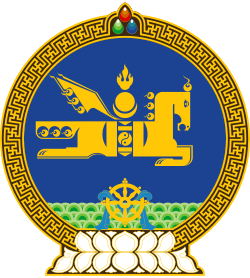Constitution of Mongolia
Constitution of Mongolia (Mongolian: Монгол Улсын Үндсэн Хууль, Mongol Ulsyn Ündsen Khuuli, "Fundamental Law of Mongolia") is the constitution of Mongolia.
| Constitution of Mongolia | |
|---|---|
| Original title | Монгол Улсын Үндсэн Хууль |
| Jurisdiction | Mongolia |
| Ratified | January 13, 1992 |
| Date effective | February 12, 1992 |
| System | Unitary semi-presidential constitutional republic |
| Branches | Three |
| Head of state | President |
| Chambers | Unicameral (State Great Khural) |
| Executive | Prime Minister led cabinet |
| Judiciary | Constitutional Court Supreme Court |
| Federalism | No |
| Electoral college | No |
| First legislature | July 20, 1992[1] |
| First executive | June 6, 1993 (President) July 21, 1992 (PM) |
| Amendments | 3 |
| Last amended | November 14, 2019 |
| Location | Ulaanbaatar |
| Commissioned by | People's Great Khural |
| Supersedes | Constitution of the Mongolian People's Republic |
 |
|---|
| This article is part of a series on the politics and government of Mongolia |
|
Executive
|
|
Legislature |
|
Judiciary |
|
It was adopted on January 13, 1992, put into force on February 12, and amended in 1999, 2000 and 2019.[2] The new constitution established a representative democracy in Mongolia, guaranteeing freedom of religion, rights, travel, expression, unalienable rights, government setup, election cycle, and other matters. It was written after the Mongolian Revolution of 1990 and dissolved the People's Republic of Mongolia. It consists of a preamble followed by six chapters divided into 70 articles.[3]
It is very close to and/or inspired by Western constitutions in terms of freedom of press, inalienable rights, freedom to travel, and other rights.
Previous constitutions had been adopted in 1924, 1940 and 1960.
Chapters
Chapter One
Declares the sovereignty and territorial integrity of the Mongolian state. Defines relationship between religion and state. Defines Mongolian emblem, flag, and anthem.[4]
Chapter Two
Specifies the civil, political, and human rights of the individual. Freedom of speech, religion, of expression, of the press, the right to vote. Equality before the law. The right to Health care, education, and intellectual property. Also lists duties of the citizen, including paying taxes and serving in the armed forces.[5]
Chapter Three
Defines the structure of the legal system and form of the republic. Describes the structure of the government.
Chapter Four
Codifies the administrative districts of Mongolia and describes the relationship between national and local government.[5]
Chapter Five
Establishes a Constitutional Court to make rulings on interpretation of the constitution.[5]
Chapter Six
Describes the amendment process for changing the constitution.[5]
2019 Constitutional amendments
Mongolia has amended its constitution strengthening the powers of the prime minister in a bid to end years of political instability and economic stagnation.[6] With the amendments, presidential term has also been shortened to single 6-year term, which could take effect in 2020 allowing current President Khaltmaagiin Battulga to run for another term in 2021[7][8].
The amendments in the constitution are supposed to enhance the economic opportunities of the Mongolian citizenry and give them better control over how the country's vast natural resources and the revenues earned from them are maintained. Furthermore, the amendments increased the independence of the judiciary by stripping the president of his power to appoint judges in key posts, and establish parliamentary rather than executive oversight over judicial matters. The amendments featured vigorous participation of ordinary people as well as incumbent politicians.[9] Proportional representation as a system to elect lawmakers were rejected, though the constitutional changes guaranteed that election laws are not changed a year before polls are held.[10]
See also
- Politics in Mongolia
- State Great Khural
- President of Mongolia
- Prime Minister of Mongolia
References
- http://parliament.mn/n/tcty
- "Mongolia amends constitution in bid to end political instability". Reuters. 2019-11-16. Retrieved 2020-01-13.
- Montsame News Agency. Mongolia. 2006, ISBN 99929-0-627-8, p. 38
- Montsame News Agency. Mongolia. 2006, ISBN 99929-0-627-8, p. 38-39
- Montsame News Agency. Mongolia. 2006, ISBN 99929-0-627-8, p. 39
- "Mongolia amends constitution in bid to end political instability". Reuters. 2019-11-16. Retrieved 2020-01-13.
- "Preserving the political status quo in Mongolia". East Asia Forum. 2020-01-10. Retrieved 2020-01-13.
- "Welcome to President Battulga's rule in 2020s". Mongolia Weekly. Retrieved 2020-01-13.
- "Mongolia's long,participatory route to constitutional reforms".
- "Mongolia amends constitution in bid to amend political instability".
Further reading
- S. Narangerel, Legal System of Mongolia, Interpress, 2004
External links
- Mongolia's Constitution of 1992 with Amendments through 2001
- Text of the constitution of Mongolia in English